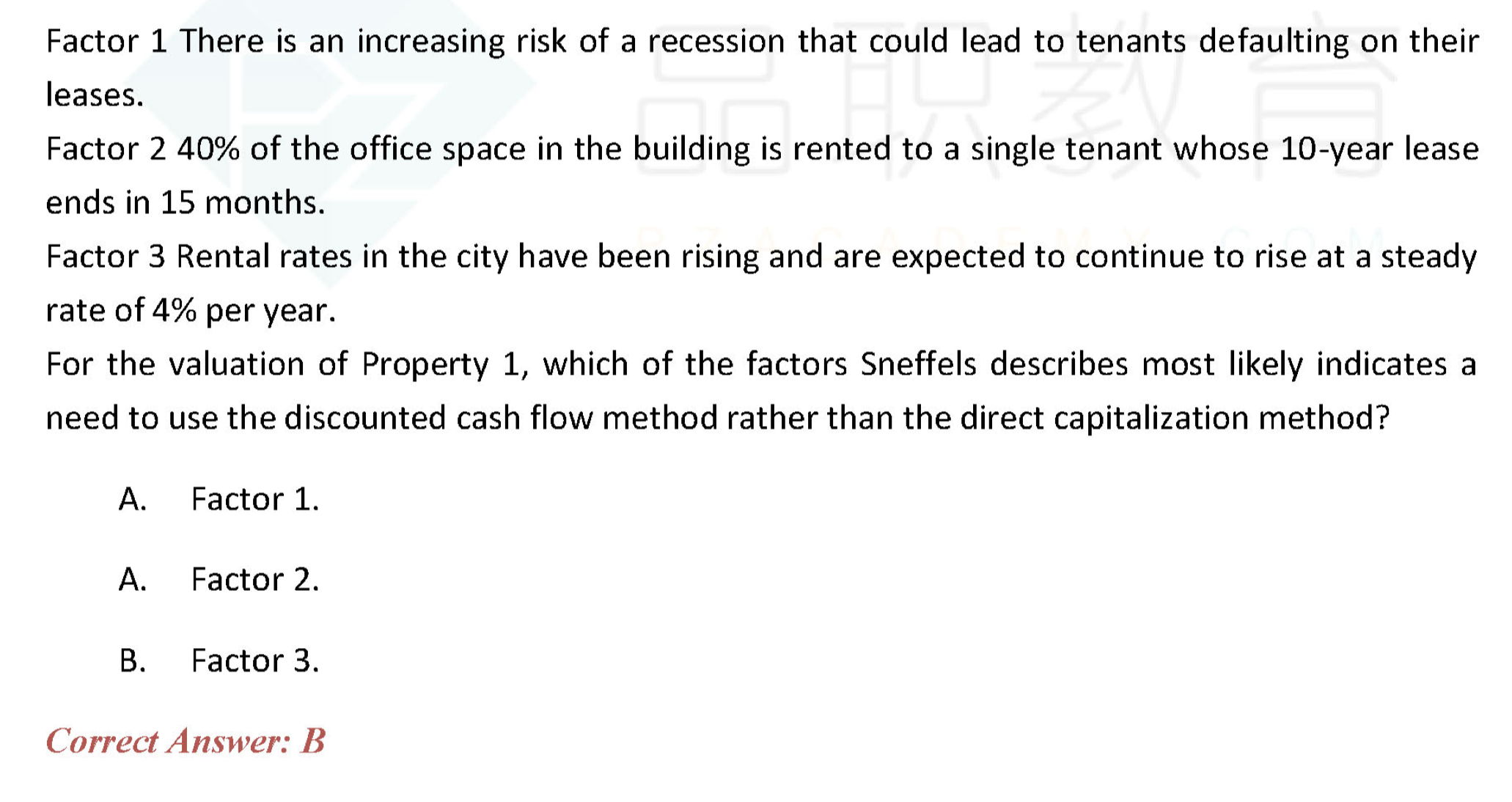NO.PZ2023041004000029
问题如下:
Property 1 is an office building located in the downtown business district of a midsize city in the United States. Property 1 has 180,000 square feet of office space plus 15,000 square feet of retail space on the ground floor. The average office space rent is $23 per square foot per year, whereas the retail space rents for twice as much. Vacancy rates over the past few years have averaged 15% for both types of space, and I expect this to remain stable into the future. Tenants only pay for utilities, janitorial, and security guard services, which cost $320,000 per year. The property manager charges 8% of effective gross rent. Other operating expenses average $1,250,000 per year. I used this information when estimating Property 1’s value using the direct capitalization method.” After Culebra’s brief of the Property 1 appraisal, Sneffels responds, “Three factors cannot be modeled using the direct capitalization method.”
Factor 1 There is an increasing risk of a recession that could lead to tenants defaulting on their leases.
Factor 2 40% of the office space in the building is rented to a single tenant whose 10-year lease ends in 15 months.
Factor 3 Rental rates in the city have been rising and are expected to continue to rise at a steady rate of 4% per year.
For the valuation of Property 1, which of the factors Sneffels describes most likely indicates a need to use the discounted cash flow method rather than the direct capitalization method?
选项:
A.Factor 1. B.Factor 2. C.Factor 3.解释:
The single tenant has been in place for almost 9 years and accounts for 40% of the office space. In 15 months, there is the risk of a very high vacancy rate for some period of time with an unknown impact (positive or negative) on future rents. This cannot be modeled with the direct capitalization method.A is incorrect. The direct capitalization method can use a lower cap rate that includes the expected decline in rental rates over time.C is incorrect. The direct capitalization method can use a higher cap rate to reflect this risk of recession.
我理解的DCM和DCF的差异,主要是如果用DCM,那么第一年的NOI必须有代表性(代表性体现在,NOI未来要稳定且有隐含的g),而DCF是每笔NOI折现,那么NOI会有差异且能准确估算,并且未来租约到期后有不确定性的风险和g导致NOI无法准确预测且re和g都不能准确预测。所以我是这样看三个选项的:
1:经济不好,租户可能违约,那么第一年的NOI没有代表性,因为未来隐含的g会变化。所以不能用DCM。而经济下滑是可以预测终值的re的,所以我觉得DCF更合适。
2:大租户的合约即将到期。我考虑的是NOI1是可以现在被确定下来的,因为这里没有提有什么环境因素会影响NOI,而且如果用DCF,那么第一阶段就1年,好像也没什么必要?估算第二年的终值和直接用DCM好像没有什么区别。
3:租金稳定增长,第一年的NOI有代表性,用DCM。
所以这题我选了1。
2有点纠结,但是比较了很久,看不出来两者太大的差异。
我认为出题人就是在考第一年的NOI有没有代表性,平不平稳,如果有代表且平稳,那么就直接用DCM。如果未来不能预期,经济环境有变化,那么就DCF。
我这个思路主要问题在哪里?



